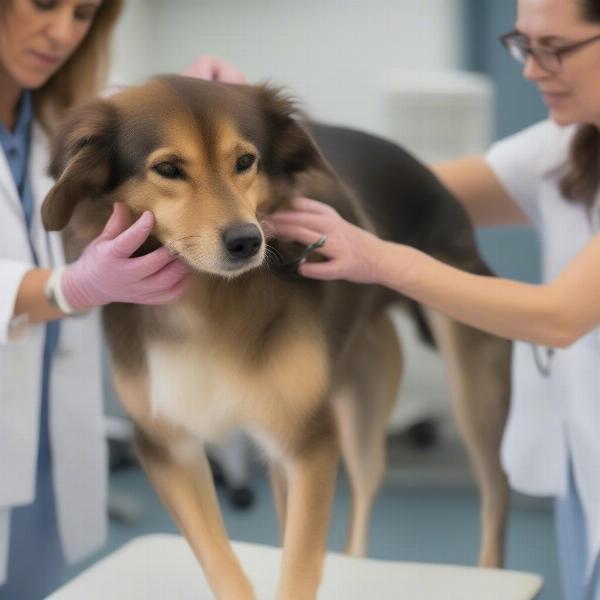Dog back legs are essential for mobility, playing, and overall well-being. Understanding their anatomy, potential problems, and how to care for them is crucial for every dog owner. This article will delve into common issues affecting dog back legs, offering practical advice on prevention, diagnosis, and treatment.
Common Back Leg Problems in Dogs
A variety of issues can affect a dog’s back legs, ranging from minor injuries to serious conditions. Recognizing the signs early on is key to ensuring your dog receives appropriate care.
- Arthritis: This degenerative joint disease is common in older dogs and can cause pain, stiffness, and reduced mobility. Signs include limping, difficulty rising, and reluctance to exercise.
- Hip Dysplasia: A genetic condition affecting the hip joint, hip dysplasia can cause lameness, pain, and difficulty walking. It’s more prevalent in larger breeds.
- Cruciate Ligament Injuries: Similar to ACL tears in humans, these injuries can occur suddenly during activity and cause severe pain and lameness.
- Luxating Patella: This condition involves the kneecap slipping out of place, causing pain and instability. It’s more common in smaller breeds.
- Degenerative Myelopathy: A progressive neurological disease affecting the spinal cord, degenerative myelopathy can lead to weakness and paralysis in the back legs.
Diagnosing Back Leg Issues
If you notice any signs of back leg problems in your dog, it’s crucial to consult a veterinarian for a proper diagnosis. The vet may perform a physical examination, take X-rays, or conduct other diagnostic tests to determine the underlying cause.
What to Expect at the Vet
Your vet will likely ask about your dog’s symptoms, medical history, and any recent injuries. Be prepared to provide as much information as possible to help them reach an accurate diagnosis.
 Veterinarian Examining Dog's Back Legs
Veterinarian Examining Dog's Back Legs
Treatment Options for Back Leg Problems
Treatment for back leg issues varies depending on the specific condition. Options may include:
- Medication: Pain relievers, anti-inflammatories, and other medications can help manage pain and inflammation.
- Physical Therapy: Exercises and stretches can improve strength, flexibility, and range of motion.
- Surgery: In some cases, surgery may be necessary to repair damaged ligaments, joints, or bones.
- Supportive Care: Providing a comfortable environment, assisting with mobility, and using assistive devices can improve your dog’s quality of life.
Caring for Your Dog’s Back Legs
Providing proper care can help prevent back leg problems and support your dog’s overall health.
- Maintain a Healthy Weight: Obesity puts extra strain on joints, increasing the risk of arthritis and other problems.
- Provide Regular Exercise: Appropriate exercise helps maintain muscle strength and joint health.
- Use Joint Supplements: Glucosamine and chondroitin supplements can help support joint health and cartilage.
- Provide a Supportive Bed: A comfortable bed can help reduce pressure on joints and improve sleep quality.
Conclusion
Your dog’s back legs are vital for their overall well-being. Understanding common back leg issues, their symptoms, and treatment options can help you provide the best possible care for your furry friend. Remember, early diagnosis and intervention are crucial for managing these conditions and ensuring your dog lives a happy and active life.
FAQ
- What are the signs of arthritis in dog back legs? Limping, stiffness, difficulty rising, reluctance to exercise, and pain are common signs.
- How is hip dysplasia diagnosed? A veterinarian will typically perform a physical exam and take X-rays to diagnose hip dysplasia.
- Can cruciate ligament injuries be treated without surgery? In some cases, conservative management with medication and physical therapy may be sufficient, but surgery is often recommended.
- What are the benefits of joint supplements for dogs? Joint supplements like glucosamine and chondroitin can help support cartilage health and reduce inflammation.
- How can I help my senior dog with weak back legs? Providing a supportive bed, using assistive devices like ramps or harnesses, and managing their weight can help improve their mobility and comfort.
- What causes sudden back leg weakness in dogs? Several factors, including injuries, intervertebral disc disease, and certain neurological conditions, can cause sudden weakness. Consult a vet immediately.
- How can I prevent back leg problems in my dog? Maintaining a healthy weight, providing regular exercise, using joint supplements (if recommended by a vet), and providing a supportive environment are key preventative measures.
ILM Dog is your trusted source for expert advice on dog care, breeds, health, training, nutrition, grooming, and products. We provide practical tips and resources to help you give your dog the best life possible. Whether you are a first-time dog owner or an experienced one, ILM Dog has the information you need. Contact us today for personalized advice and support: Email: [email protected], Phone: +44 20-3965-8624. Visit our website ILM Dog to learn more!